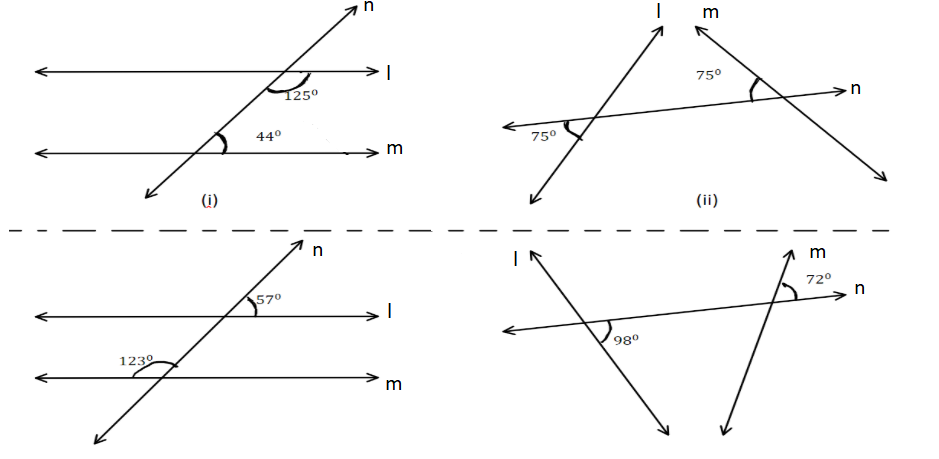Answer
401.4k+ views
Hint: Whenever the pair of alternate angles of any two or more lines are equal then these lines are parallel. The pair of interior angles on the same side of transversals is supplementary then we can say that the lines are parallel to each other. Similarly there are other conditions also which figures given above must satisfy only then we can say that \[l\] is parallel to \[m\].
Complete step by step solution:
Now let us begin with figure 1 and then we will move to other figures to find whether \[l\] is parallel to \[m\]or not.
In figure 1.
There are two angles given in fig. 1 and both the angles are interior angles. Let us name them as \[\angle A\] and \[\angle B\].
So, \[\angle A = 125^\circ \] and \[\angle B = 44^\circ \]
And by the property of parallel lines we know the sum of interior angles on same side of parallel lines must be supplementary ( i.e. = \[180^\circ \] )
So, \[\angle A + \angle B\] must equal to \[180^\circ \].
But \[125^\circ + 44^\circ = 169^\circ \ne 180^\circ \]
So, \[l\] is not parallel to \[m\] in figure 1.
In figure 2
Now let us assume the angles of fig. 2 as \[\angle P\] and \[\angle Q\]. It is given that \[\angle P = \angle Q = 75^\circ \]
As we know when the when the pair of alternate angles of two or more lines are equal then these are parallel and these two angles have same values but they are not alternate angles
So, \[l\] is not parallel to \[m\] in figure 2.
In figure 3.
Now let us assume the angles of fig 3 as \[\angle M\]and \[\angle N\].
As we know that \[\angle M\]and \[\angle N\]are alternate interior angles. So, by property the sum of these angles must be supplementary ( i.e. = \[180^\circ \] ).
\[ \Rightarrow \]\[57^\circ + 123^\circ = 180^\circ \]
So, in fig. 3 \[l\] is parallel to \[m\].
In figure 4.
Now let us assume the angles of fig. 4 as \[\angle X\]and \[\angle Y\]. And we had discussed above that the sum of these angles must be \[180^\circ \].
\[ \Rightarrow 98^\circ + 72^\circ = 170^\circ \ne 180^\circ \]
So, in fig. 4 \[l\] is not parallel to \[m\].
Note: Whenever we come up with this type of problem we must keep in mind that two lines are parallel only when both lines satisfy all the properties or conditions of two or more parallel lines that we had studied in earlier standards.
Complete step by step solution:
Now let us begin with figure 1 and then we will move to other figures to find whether \[l\] is parallel to \[m\]or not.
In figure 1.
There are two angles given in fig. 1 and both the angles are interior angles. Let us name them as \[\angle A\] and \[\angle B\].
So, \[\angle A = 125^\circ \] and \[\angle B = 44^\circ \]
And by the property of parallel lines we know the sum of interior angles on same side of parallel lines must be supplementary ( i.e. = \[180^\circ \] )
So, \[\angle A + \angle B\] must equal to \[180^\circ \].
But \[125^\circ + 44^\circ = 169^\circ \ne 180^\circ \]
So, \[l\] is not parallel to \[m\] in figure 1.
In figure 2
Now let us assume the angles of fig. 2 as \[\angle P\] and \[\angle Q\]. It is given that \[\angle P = \angle Q = 75^\circ \]
As we know when the when the pair of alternate angles of two or more lines are equal then these are parallel and these two angles have same values but they are not alternate angles
So, \[l\] is not parallel to \[m\] in figure 2.
In figure 3.
Now let us assume the angles of fig 3 as \[\angle M\]and \[\angle N\].
As we know that \[\angle M\]and \[\angle N\]are alternate interior angles. So, by property the sum of these angles must be supplementary ( i.e. = \[180^\circ \] ).
\[ \Rightarrow \]\[57^\circ + 123^\circ = 180^\circ \]
So, in fig. 3 \[l\] is parallel to \[m\].
In figure 4.
Now let us assume the angles of fig. 4 as \[\angle X\]and \[\angle Y\]. And we had discussed above that the sum of these angles must be \[180^\circ \].
\[ \Rightarrow 98^\circ + 72^\circ = 170^\circ \ne 180^\circ \]
So, in fig. 4 \[l\] is not parallel to \[m\].
Note: Whenever we come up with this type of problem we must keep in mind that two lines are parallel only when both lines satisfy all the properties or conditions of two or more parallel lines that we had studied in earlier standards.
Recently Updated Pages
The branch of science which deals with nature and natural class 10 physics CBSE

The Equation xxx + 2 is Satisfied when x is Equal to Class 10 Maths

Define absolute refractive index of a medium

Find out what do the algal bloom and redtides sign class 10 biology CBSE

Prove that the function fleft x right xn is continuous class 12 maths CBSE

Find the values of other five trigonometric functions class 10 maths CBSE

Trending doubts
Difference between Prokaryotic cell and Eukaryotic class 11 biology CBSE

Fill the blanks with the suitable prepositions 1 The class 9 english CBSE

Write an application to the principal requesting five class 10 english CBSE

Difference Between Plant Cell and Animal Cell

a Tabulate the differences in the characteristics of class 12 chemistry CBSE

Change the following sentences into negative and interrogative class 10 english CBSE

What organs are located on the left side of your body class 11 biology CBSE

Discuss what these phrases mean to you A a yellow wood class 9 english CBSE

List some examples of Rabi and Kharif crops class 8 biology CBSE




